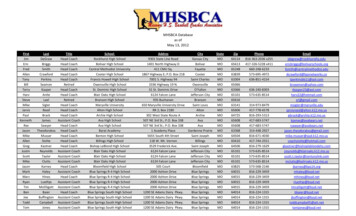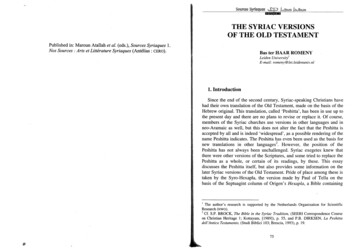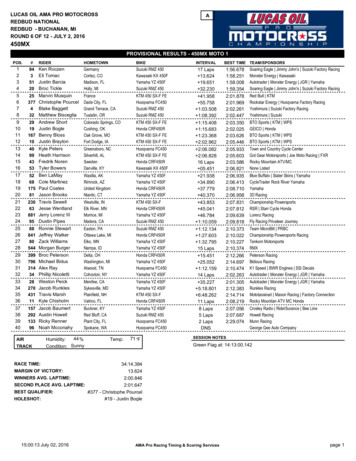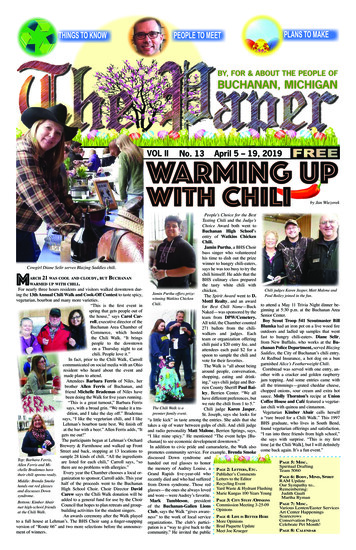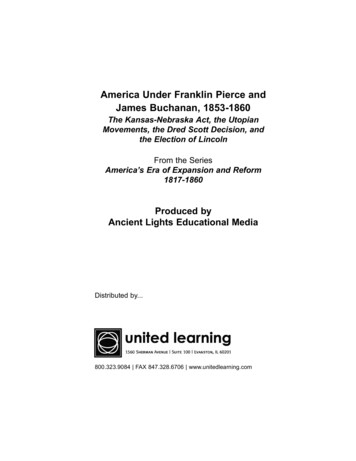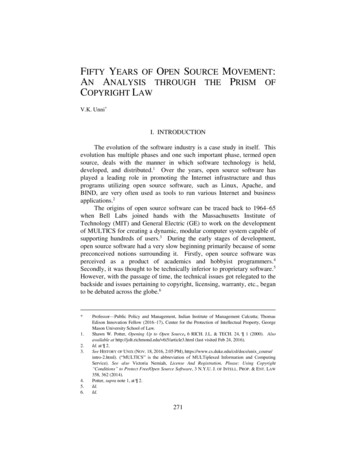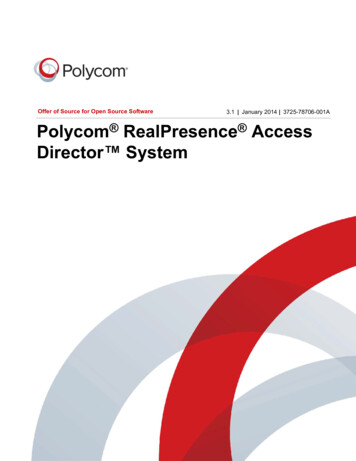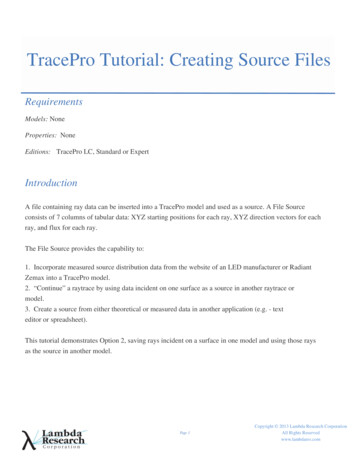
Transcription
Wicked Problems in Design ThinkingAuthor(s): Richard BuchananSource: Design Issues, Vol. 8, No. 2, (Spring, 1992), pp. 5-21Published by: The MIT PressStable URL: http://www.jstor.org/stable/1511637Accessed: 11/04/2008 09:41Your use of the JSTOR archive indicates your acceptance of JSTOR's Terms and Conditions of Use, available rms.jsp. JSTOR's Terms and Conditions of Use provides, in part, that unlessyou have obtained prior permission, you may not download an entire issue of a journal or multiple copies of articles, and youmay use content in the JSTOR archive only for your personal, non-commercial use.Please contact the publisher regarding any further use of this work. Publisher contact information may be obtained herCode mitpress.Each copy of any part of a JSTOR transmission must contain the same copyright notice that appears on the screen or printedpage of such transmission.JSTOR is a not-for-profit organization founded in 1995 to build trusted digital archives for scholarship. We enable thescholarly community to preserve their work and the materials they rely upon, and to build a common research platform thatpromotes the discovery and use of these resources. For more information about JSTOR, please contact support@jstor.org.http://www.jstor.org
.Richard Buchananin DesignThinkingWickedProblemsThisessayis basedon a paperpresentedat"Colloque Recherchessur le irst Frenchuniversitysymposiumondesign researchheld October 1990 rance.IntroductionDespite effortsto discoverthe foundationsof designthinkinginthe fine arts,the naturalsciences,or most recently,the socialsciences,designeludesreductionandremainsa surprisinglyflexibleactivity. No single definition of design, or branchesof professionalizedpracticesuchas industrialor graphicdesign,adequatelycoversthe diversityof ideasandmethodsgatheredtogetherunderthe label. Indeed,the varietyof researchreportedin conferencepapers,journalarticles,andbooks suggeststhatdesigncontinuesto expandin its meaningsand connections,revealingunexpecteddimensionsin practiceas well as understanding.This follows thetrendof designthinkingin the twentiethcentury,for we haveseento afielddesigngrowfroma tradeactivityto a segmentedprofessionfor technicalresearchandto what now shouldbe recognizedas anew liberalart of technologicalculture.It may seem unusualto talk about designas a liberalart,particularlywhen many people are accustomedto identifying theliberalartswith the traditional"artsand sciences"that are institutionalizedin colleges and universities.But the liberalarts areundergoinga revolutionarytransformationin twentieth-centuryculture, and design is one of the areasin which this transformationis strikingly evident.To understandthe change that is now underway, it is importantto recognize that what are commonly regarded as the liberal artstoday are not outside of history. They originatedin the Renaissanceand underwentprolonged development that culminatedin the nineteenth century as a vision of an encyclopedic educationof beaux arts,belles lettres,history, various naturalsciences and mathematics,philosophy, and the fledgling social sciences. This circle of learningwas divided into particular subject matters, each with a propermethod or set of methods suitable to its exploration. At their peakas liberal arts, these subject matters provided an integrated understandingof human experienceand the arrayof availableknowledge.By the end of the nineteenth century, however, existing subjectswere explored with progressively more refined methods, and newsubjects were added to accord with advances in knowledge. As aDesign Issues: Vol. VIII, Number 2 Spring 19925
1) From Richard McKeon, "TheTransformation of the Liberal Arts inthe Renaissance," Developments inthe Early Renaissance, ed. Bernard S.Levy (Albany: State University ofNew York Press, 1972), 168-69.2) Neo-positivism, pragmatism, and various forms of phenomenology havestrongly influenced design educationand practice in the twentieth century.If design theory has often tendedtoward neo-positivism, design practice has tended toward pragmatismand pluralism,with phenomenologistsin both areas. Such philosophical differences are illustrated in the split thatdeveloped between the theoreticalandstudio courses at the Hochschule furGestaltung (HfG) Ulm before its closing. The split between theory andpracticein design is an echo of the difference between the predominantlyneo-positivist philosophy of scienceand the exceptionally diverse philosophies of practicing scientists. Designhistory, theory, and criticism couldbenefit from closer attention to thepluralism of views that guide actualdesign practice.3) Walter Groupius was one of the first torecognize the beginnings of a new liberal art in design. In an essay writtenin 1937, he reflected on the foundingof the Bauhaus as an institutiongrounded on the idea of an architectonic art: "Thus the Bauhaus wasinaugurated in 1919 with the specificobject of realizing a modern architectonic art,which like human naturewasmeant to be all-embracingin its scope. Our guiding principle was thatdesign is neither an intellectual nor amaterial affair, but simply an integralpart of the stuff of life, necessary foreveryone in a civilized society." Scopeof Total Architecture (New York:Collier Books, 1970), 19-20. The term"architectonic,"in this case, transcendsthe derivative term "architecture" asit is commonly used in the modernworld. Throughout Western culture,the liberal arts have similarly beendescribed as "architectonic" becauseof their integrativecapacity. Groupiusappeared to understand that architecture, regardedas a liberalart in its ownright in the ancient world, was onlyone manifestation of the architectonic art of design in the twentiethcentury.4) John Dewey, The Quest for Certainty:A Study of the Relation of Knowledgeand Action (1929; rpt. New York:Capricorn Books, 1960), 290-91.6result,the circleof learningwas furtherdividedand subdivided,untilall thatremainedwas a patchworkquiltof specializations.Today, these subjectmattersretainan echo of theirold statusas liberalarts,buttheyflourishas specializedstudies,leadingto theperceptionof an evermorerichanddetailedarrayof factsandvalues.Althoughthesesubjectscontributeto theadvanceof knowledge,as they havebecomeprothey alsocontributeto its fragmentation,gressively narrow in scope, more numerous, and have lost"connectionwith eachotherandwith the commonproblemsandmattersof daily life from which they select aspects for precisemethodologicalanalysis."'The searchfor new integrativedisciplinesto complementthe artsandscienceshasbecomeone of thecentralthemesof intellectualandpracticallife in the twentiethcentury. Without integrative disciplines of understanding,communication,andaction,thereis littlehope of sensiblyextending knowledgebeyondthe libraryor laboratoryin orderto servethe purposeof enrichinghumanlife.The emergenceof designthinkingin the twentiethcenturyisimportantin this context.The significanceof seekinga scientificbasisfor designdoes not lie in the likelihoodof reducingdesigntoone or anotherof the sciences-anextensionof the neo-positivistprojectandstillpresentedin thesetermsby somedesigntheoristsRather,it lies in a concernto connectandintegrateusefulknowledge from the artsand sciencesalike,but in ways that are suitedto theproblemsandpurposesof thepresent.Designers,areexploring concreteintegrationsof knowledgethatwill combinetheorywith practicefor new productivepurposes,and this is the reasonwhy we turnto designthinkingfor insightinto the new liberalartsof technologicalcultureDesign and Intentional OperationsThe beginningof the study of designas a liberalartcan be tracedto the culturalupheavalthatoccurredin the earlypartof the twentieth century.The key featureof this upheavalwas describedbyJohnDewey in TheQuestforCertaintyas the perceptionof a newcenterof the universe.Theold centerof theuniversewasthemindknowingby,meansof anequipmentof nantecedentexternalmaterial equallycompletewithin itself. The new centerisindefiniteinteractionstakingplacewithin a courseofnaturewhichis notfixedandcomplete,butwhichis capable of directionto new anddifferentresultsthroughthemediationof intentionaloperations.WhatDewey describeshereis the root of the differencebetweenthe old andnew liberalarts,betweenspecializationin the factsof asubjectmatterandtheuseof new disciplinesof integrativethinking.
5) John Dewey, Experience and Nature(1929; rpt. New York: DoverPublications, Inc., 1958), 357.6) Dewey, Experience and Nature, 35758.International7) The neo-positivistEncyclopedia of Unified Science,which included Charles Morris'sFoundations of the Theory of Signs,also included Dewey's Theory ofValuation. However, Dewey's Logicwas ignored or ridiculed by neo-positivist logicians and grammarians.8) John Dewey, "By Nature and By Art,"Philosophy of Education (Problemsof Men) (1946; rpt. Totowa, NewJersey: Littlefield, Adams, 1958), 288.9) Dewey, "By Nature and By Art," 29192.Dewey observes,however,that the meaningand implicationsof the new directionarestill not fully understood.Nowadayswe havea messyconjunctionof notionsthatare consistentneitherwith one anothernor with thetenorof our actuallife. Knowledgeis still regardedbymostthinkersasdirectgraspof ultimatereality,althoughthepracticeof knowinghasbeenassimilatedto theprocedureof theusefularts;-involving,thatis to say,doingthat manipulatesand arrangesnaturalenergies.Againwhile science is said to lay hold of reality,yet "art"insteadof beingassigneda lowerrankis sfurther,Dewey exploresthe new relationshipbetweenscience,art,andpractice.He suggestsin Experienceand Nature that knowledgeis no longerachievedby directconformity of ideas with the fixed orders of nature;knowledge isachievedby a new kind of artdirectedtowardordersof change.Butif moderntendenciesarejustifiedin puttingartandcreationfirst, then the implicationsof this positionshouldbe avowedandcarriedthrough.It would thenbe seen that scienceis an art, that art is practice,andthatthe only distinctionworthdrawingis not betweenpracticeandtheory,but betweenthose modesof practice that are not intelligent, not inherently andimmediatelyenjoyable, and those which are full ofenjoyedmeanings.Althoughthe neo-positivistscourtedDewey for a time,it wasapparentthat his understandingof the developmentof scienceinthe twentiethcenturywas quite differentfrom theirunderstanding7.Insteadof treatingscienceas primaryand art as secondary,Dewey pointedtowardscienceas art.Theconsiderationthatcompletesthe groundfor assimilating science to art is the fact that assignment ofscientificstatusin oduced.Scienceis now the product of operationsdeliberatelyundertakenin conformitywith a planor projectthathasthepropertiesof a working hypothesis.WhatDeweymeansby "art"in thiscontextis crucialto understandculture.ingthenewroleof designandtechnologyin contemporaryAftera periodin crafts,scienceentereduponborrowinga periodof steadyandever-acceleratedgrowthby meansof deliberateinventionof such applianceson its ownaccount.Inorderto markthisdifferentialfeatureof theartwhichis science,I shallnow usetheword"technology.". Becauseof technologies,acircularbetweenrelationshiptheartsof productionandsciencehasbeenestablished.Design Issues: Vol. VIII, Number 2 Spring 19927
10) For Dewey, the artsof production,includethefinearts.He makesno sharpshadtinction betweenbeteen fineandusefuldistinctionarts.What Dewey defines as technology is not what is commonlyunderstoodin today'sphilosophyof technology.Insteadof meaning knowledgeof how to makeand use artifactsor the artifactsthemselves,technologyfor Dewey is anartof experimentalthinking. It is, in fact, intentionaloperationsthemselvescarriedout inthe sciences,the artsof production, or socialandpoliticalaction.We mistakenly identify technology with one particular type ofproduct-hardware-that may result from experimentalthinking, but overlookthe artthatlies behindandprovidesthe basisforcreatingother types of products.Fromthis perspective,it is easy to understandwhy designanddesign thinkingcontinueto expandtheir meaningsand connections in contemporaryculture.Thereis no areaof contemporarylife wheredesign-the plan,project,or workinghypothesiswhichconstitutesthe "intention"in intentionaloperations-is not a significantfactorin shapinghumanexperience.Design evenextendsinto the coreof traditionalscientificactivities,whereit is employedto cultivate the subject mattersthat are the focus of scientificcuriosity.But perceivingthe existenceof such an art only opensthe door to furtherinquiry, to explainwhat that art is, how itoperates,andwhy it succeedsor failsin particularsituations.Thechallengeis to gaina deeperunderstandingof designthinkingsothat more cooperation and mutual benefit is possible betweenthosewho applydesignthinkingto ill helpto makethepracticalexplorationof design,particularlyin the artsof production,more intelligentand meaningful.However,a persistentproblemin this regardis thatdiscussionsbetweendesignersand membersof the scientificcommunitytendto leavelittle room for reflectionon the broadernatureof designandits relationto the artsand hegeneralpublicthatultimatelying,marketinguses the resultsof designthinking.Insteadof yieldingproductiveintegrations,the resultis oftenconfusionanda breakdownof communication,with a lack of intelligentpracticeto carryinnovativeideasinto objective,concreteembodiment.In turn,thisundermineseffortsto reacha clearerunderstandingof designitself,sometimesdrivingdesignersbackinto a defenseof theirwork in the contextof ionto cipants,amongis littlehope of understandingthe foundationsandvalueof designthinkingin an increasinglycomplextechnologicalculture.The Doctrine of PlacementsBy "liberalart"I meana disciplineof thinkingthatmaybe sharedto some degreeby all men andwomen in their daily lives and is,in turn,masteredby a few peoplewho practicethe eit to new areasof inno8
11)HerbertA. Simon,TheSciencesof houghSimon'sTheSciencesof theArtificialis citedrepeatedlyin designliteraturebecauseof its definitionofdesign,it is oftenreadwithlittleattention given to the full argument.Acarefulanalysisfromthe standpointof industrialdesignwould be a useSuchfulcontributionto theliterature.a readingwould revealthe positivistandhelpfeaturesof Simon'sapproachto explainwhy many designersaresomewhat disenchantedwith thebook. Nonetheless, it remains anexceptionallyusefulwork.13) See ernicanRevolution,"Revue des sciencesettechniquesde la conception (TheJournal of Design Sciences shculture"is usedby literarycriticGeorgeSteinerandis a themein a forthcomingbook byof theText.IvanIllich,IntheVineyard15)Thedesignof materialobjectsincludes,of course,new workin materialsscience,wherea highlyfocusedformofdesignthinkingis evident.vativeapplication.Perhapsthisis whatHerbertSimonmeantin TheSciencesof the Artificial,one of the majorworks of designtheoryin the twentieth century,when he wrote: "the proper study ofmankindis the scienceof design,not only as theprofessionalcomponent of a technicaleducationbut as a core disciplinefor everyliberallyeducatedman.""One mayreasonablydisagreewithaspectsof Simon'spositivistand empiricistview of design as a science(asone ndtheofobservationimportanceof intentionaloperationsDewey'sin modernculture),'but thereis little reasonto disagreewith theidea that all men and women may benefitfrom an early understandingof the disciplinesof designin the contemporaryworld.The beginningof such an understandinghas alreadyturnedthestudy of the traditionalarts and sciencestoward a new engagement with the problemsof everydayexperience,evident in thedevelopmentof diversenew productswhich incorporateknowledgefrom manyfieldsof specializedinquiry.To gain some idea of how extensivelydesign n whichdesignis exploredthroughoutthe worldby professionaldesignersandby manyotherswho maynot regardthemselvesas designers.The firstof theseThisareasis the design of symbolicand visual communications.includesthe traditionalwork of graphicdesign,such as typography andadvertising,book t has expandedinto communicationthroughphotography, film, television, and computer display. The area ofcommunicationsdesign is rapidlyevolving into a broad explorationof the problemsof a new synthesisof words and imagesthat istransformingthe "bookishculture"of the past.lThe secondareais the designof materialobjects.This includesof everydaytraditionalconcernfor the formandvisualappearanceproducts-clothing, domesticobjects,tools, instruments,machinery, and vehicles-but has expandedinto a more thoroughanddiverseinterpretationof the physical,psychological,social, elationshipsis rapidlyevolving into an explorationof the problemsof conmustcarrya deeper,structionin whichformandvisualappearancemore integrativeargumentthat unitesaspectsof art,engineeringandnaturalscience,andthe humansciences.5The thirdareais the designof activitiesand organizedservices,which includesthe traditionalmanagementconcernfor ,instrumentalities,in efficientsequencesand schedulesto reachspecifiedobjectives.However, this areahas expandedinto a concernfor logicaldecision makingandstrategicplanningandis rapidlyevolvinginto anexplorationof how betterdesignthinkingcancontributeto achievinganorganicflow of experiencein concretesituations,makingsuchDesign Issues: Vol. VIII, Number 2 Spring 19929
experiences more intelligent, meaningful, and satisfying. The central theme of this area is connections and consequences. Designersare exploring a progressively wider range of connections in everyday experience and how different types of connections affect theandSomeofthesocialstructure of action.616)psychologicalof thisareaareillustratedindimensionsThe fourth area is the design of complex systems or environworksas diverseas GeorgeA. Miller,mentsandKarlH.Galanter,Pribram,Eugenefor living, working, playing, and learning. This includes theofBehaviorPlansandtheStructure(New traditionalconcerns ofsystems engineering,architecture,and urbanYork:Holt, Rinehartand Winston,PlansandSituated planning or the functional analysis of the parts of complex wholes1960);LucySuchman,Actions:The Problem of Human- and theirsubsequent integration in hierarchies. But this area hasMachineCommunication(Cambridge:alsoexpanded and reflects more consciousness of the central alyCsikszentmihalyi,thought, or value that expresses the unity of any balancedand funcPsychology of OptimalExperiencetioning whole. This areais more and more concernedwith exploring(NewYork:Harper& Row,1990).the role of design in sustaining, developing, and integrating humanbeings into broader ecological and cultural environments, shapingthese environments when desirable and possible or adapting to17)Oneof theearlyworksof systemsengi- them when ecting on this list of the areasof design thinking, it is temptis ArthurD. Hall,A Methodologyforto identify and limit specific design professions within eachNewing(Princeton,SystemsEngineeringJersey:D. VanNostrandCompany, area-graphic designers with communication, industrial designers1962).For morerecentdevelopmentsin systemsthinking,see Ron Levy, and engineers with materialobjects, designers-cum-managerswith"CriticalSystems Thinking:Edgar activitiesand services,and architectsand urbanplannerswith systemsMorin and the French School ofandButnotenvironments.thiswouldbeadequate, because theseThought,"SystemsPractice,vol. 4newthe(1990).Regarding"systemics," areas are not simply categories of objects that reflect the results ofseeRobertL.FloodandWernerUlrich,understood and used, they are alsoplaces of invento ConversationsonCritical design. Properly"TestamentBetweenTwoallsharedtionSystems Thinkingby designers,placeswhere one discoversthe dimensionsSystems Practitioners," Systems ofdesign thinking by a reconsiderationof problems and solutions.Practice,vol. 3 (1990), and M. C.Kernelin"TheCriticalTrue, these four areas point toward certain kinds of y human experience, and the work of designers in each of thesePractice,vol. 3 (1990).For an anthroto systems,seeJames areas has created a framework for human experience in contemapproachpologicalHolston, The ModernistCity: An porary culture. But these areas are also interconnected, with noAnthropologicalCritiqueof Brasiliatoone. For example, the sequence of signs,Universityof ChicagoPress, priority given any single(Chicago:1989).things, actions, and thought could be regarded as an ascent fromconfusing parts to orderly wholes. Signs and images are fragmentsof experiencethat reflectour perception of materialobjects.Materialobjects, in turn, become instruments of action. Signs, things, andactions are organized in complex environments by a unifying ideaor thought. But there is no reason to believe that parts and wholesmust be treated in ascending rather than descending order. PartsthePlatonic,and and whole are of many types and may be defined in many ways.Aristotelian,18)Comparetreatmentsof partsclassicmaterialiston how a designerwishes to explore and organize expeto Dependingandwholes.Thesethreeapproachesarewell rience,the sequence could just as reasonablybe regardedas a descenttheorganizationof experienceintwentiethcenturydesign from chaotic environments to the unity provided by symbols tes on the Synthesisof images. In fact, signs, things, actions, and thoughts are not onlyAlexander,Form(Cambridge:HarvardUniversity interconnected, they also interpenetrate and merge in contempoPress,1973).rary design thinking with surprising consequences for innovation.These areassuggest the lineage of design's past and present, as wellas point to where design is headed in the future.10
arethemeasureof objec19)Suchjudgmentstivityin contemporarydesignthinking.Withoutobjectivityto ersseeksto repositiontheproblemsof architecturein anewperceptionof multipleoverlappingsystems,rejectingthe notionof a system as "linear,static,hierarchicalandmechanicalorder." According toRogers:"Todaywe knowthatdesignbased on linear reasoningmust besupersededby an open-endedarchitectureof overlappingsystems.Thisallowsus to whole;weare,inarchitecture,asinotherfields,a holisticecologicalviewapproachingof theglobeandthewaywe liveon it."A ModernView . Rogers'snotionof "indeterminateform"derivesnotfromtheideasof literary deconstructionbut from hisinnovativeview of multiplesystems.Formoreon Rogers'spointedcriticismof postmodernarchitecturefromtheperspectiveof multiplesystems,seeA ModernView,26.Architecture:It is easyto rnedwith materialobjects.But the researchreportedin designliteratureshows thatindustrialdesignershavefoundnew avenuesof explorationby thinkingaboutmaterialobjectsin the contextofsigns, actions,and thoughts.For example,some have lectionson the semantic andrhetoricalaspectsof products.Othershaveplacedmaterialobjectsin the contextof experienceand action,askingnew questions about how productsfunctionin situationsof use and howthey maycontributeto or inhibitthe flow of activities.(Of course,this is a significantshift from questionsabout the internalfunctioningof productsandhow thevisualformof a exploringmaterialobjectsaspartof largersystems,cycles,andenvironments,openingup a wideofnewandconcernsorrangequestions rvationandrecycling,alternativetechnologies, l,andlegaldimensions of design.Comparablemovementsareevidentin eachof the designprofessions:theirprimaryconcernbeginsin one area,but innovationcomeswhen the initialselectionis repositionedat anotherpoint inthe framework,raisingnew questionsandideas.Examplesof thisrepositioningabound.For example,architecturehastraditionallybeen concernedwith buildingsas largesystemsor environments.Fornearlytwentyyears,however,a groupof architectshaveaggressively sought to reposition architecturein the context of signs,symbols, and visual communication,yielding the postmodernexperimentand trends such as ntheOxymoronssuchas "deconstructionistresultof attemptsatinnovativerepositioning.indicatea desireTheyto breakold categories,as in the now inting."Thetest,of course,is whetherexperimentsin innovationyieldproductiveresults,judgedby individualsandby society as a whole. Someexperimentshavefallenlike deadleavesat the firstfrost,sweptawayto mercifuloblivion.At present,the resultsof deconstructionistarchitecturearemixed,but the experimentwill continueuntilindividualsor groupsreposition the problems of architectureand shift generalattention20toward new questions.2A strikinglydifferentrepositioningis now beginningin theprofession of graphicdesign and visual communication.In the latenineteenthand earlytwentiethcenturies,graphicdesignwas .It was anextensionof the expressivenessof the fine arts,pressedinto commercialor scientificservice.Thiswas modifiedunderthe influenceof "communicationtheory"and semioticswhen the role of thegraphicdesignerwas shiftedtowardthatof an interpreterof mesDesign Issues: Vol. VIII, Number 2 Spring 199211
21) Althoughstilla common andusefulwayof studying visual communication,thisapproachhaslost some of its initialforcein actualdesign practicebecause it hasmoved into personalidiosyncracyandasearchfor novelty,which often distractsone from the central tasks of effectivecommunication. This is evident, forexample,amongthose graphicdesignerswho have made pedestrianreadingsofdeconstructionist literary theory therationalefor their work. Visual experimentationis an importantpartof graphicdesign thinking, but experimentationmust finallybe judgedby relevanceandeffectivenessof communication.For adiscussionof the limitsof semioticsanddesign, see Seppo Vakeva, "What DoWe Need Semiotics For?," SemanticVisions in Design, ed. Susann Vihma(Helsinki:Universityof IndustrialArtsUIAH, 1990),g-2.22) Swiss graphicdesignerRuedi Ruegg hasrecently spoken of the need for morefantasy and freedom in graphicdesignthinking. Based on his approach, onemight argue that efforts to introducedeconstructionist literary theory intographicdesignhaveoften led to a loss offreedom and imagination in effectivecommunication,contraryto the claimsof its proponents.12sages.Forexample,the graphicdesignerintroducedemotionalcolorings of corporateor public "messages"or, in technicalterms,the graphicdesigner"coded"the corporatemessage.As a result,the productsof graphicdesignwere viewed as "things"or "entities" (materialtexts) to be "decoded"by spectators. Recently,however,a new approachin graphicdesignthinkinghasbeguntoquestionthe essentiallylinguisticor grammaticalapproachof communications theory and semiotics by regarding visualcommunicationaspersuasiveargumentation.As thisworkunfolds,it will likely seek to repositiongraphicdesignwithin the dynamic flow of lationshipsamonggraphicdesigners,audiences,andthe contentof communication.In this situation,designerswould no longerbeviewedas individualswho decoratemessages,but as communicators who seek to discoverconvincingargumentsby meansof anew synthesisof imagesandwords. In turn,this will shift attenin reachingconclusionstion towardaudiencesas activeparticipantsratherthanpassiverecipientsof preformedmessages.What works for movementswithin a design profession alsoworks for individualdesignersandtheirclientsin addressingspecific problems.Managersof a largeretailchainwere puzzled thatcustomershad difficultynavigatingthroughtheir stores to gersignsbutnoapparentimprovementin navigation-the largerthe sign,the morelikelypeoplewereto ignoreit. Finally,a designconsultantsuggestedthat the problem should be studiedfrom the perspectiveof theflow of customerexperience.Aftera periodof observingshopperswalkingthroughstores,the consultantconcludedthatpeopleoftennavigateamong differentsections of a store by looking for themost familiarand representativeexamplesof a particulartype ofproduct.This led to a changein display lyto identifyin prominentpositions. Althoughthis is a minorexample,it does illustratea doublerepositioningof the design problem:first, from signs to action,with aninsightthatpeoplelook for familiarproductsto guidetheirmovements;second,fromactionto signs,a redesignof displaystrategy to employ produc
Wicked Problems in Design Thinking This essay is based on a paper presented at "Colloque Recherches sur le Design: Incitations, Implications, Interactions," the first French university symposium on design research held October 1990 at l'Universite de Technologie de Compiegne, Compilgne, France. Introduction
